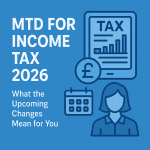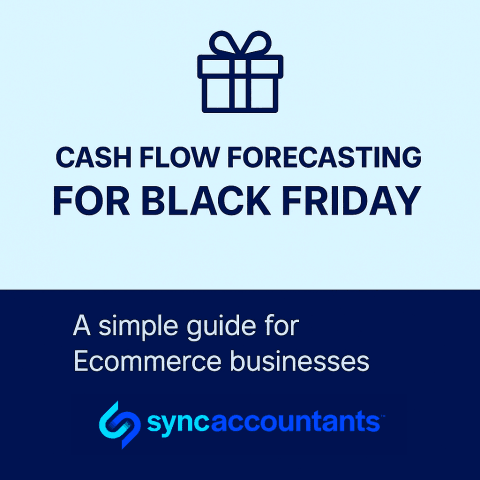
MTD for Income Tax 2026: What the Upcoming Changes Mean for You
October 30, 2025
Upcoming UK Budget for Online Sellers: What It Could Mean for Margins, Cash Flow, and Planning
November 13, 2025Introduction
Black Friday is one of the biggest opportunities for ecommerce businesses to boost revenue, but it can also create serious cash flow challenges. While your sales numbers might look impressive, the combination of heavy discounting, upfront inventory costs, and delayed payment processing can leave you scrambling for cash when you need it most. Cash flow forecasting Black Friday is essential to ensure your business survives and thrives during this critical trading period. In this guide, we’ll walk you through practical steps to forecast your cash flow effectively around major sales events, so you can plan ahead and avoid nasty surprises.
Why Black Friday Creates Cash Flow Problems
Even though Black Friday generates massive sales volumes, it creates a perfect storm for cash flow issues. First, you need to buy and pay for inventory weeks or even months before the event, tying up significant capital. Second, the deep discounts mean your profit margins are thinner than usual. Third, payment processing delays mean the cash from sales doesn’t hit your account immediately it can take days or even weeks depending on your payment provider. Add to this the increased costs of advertising, extra staff, and higher return rates after the event, and you can see why cash flow forecasting Black Friday is absolutely critical for ecommerce success.
Starting Your Cash Flow Forecast
The foundation of good cash flow forecasting is understanding your numbers from previous years. Look at your historical Black Friday data. how much did you sell, what were your costs, and how quickly did payments arrive? Use this information to create realistic projections for the upcoming event. A rolling 13-week cash flow forecast is ideal for this purpose, as it gives you enough visibility to spot potential shortfalls early. Break down your forecast into weekly segments, and include all expected cash inflows (sales revenue, payment processing) and outflows (inventory purchases, marketing spends, staff costs, platform fees).
Building Scenario-Based Forecasts
Don’t rely on a single forecast create multiple scenarios to prepare for different outcomes. Develop a best-case scenario where sales exceed expectations, a worst-case where they fall short, and a most-likely scenario based on realistic assumptions. This approach helps you understand how much cash you’ll need in different situations and what actions you might need to take. For example, in your worst-case scenario, you might need to arrange additional financing or reduce marketing spend quickly. Having these plans ready means, you can react fast if things don’t go as expected during cash flow forecasting Black Friday preparations.
Managing Inventory and Supplier Payments
Your biggest cash outflow ahead of Black Friday will be inventory purchases. Work with your suppliers to negotiate better payment terms, can you extend payment from 30 to 60 days, or negotiate a deposit with the balance due after sales come in? This flexibility can make a huge difference to your cash position. Use data-driven demand forecasting to avoid overstocking, which ties up cash in inventory that might not sell. Consider focusing your promotions on high-margin products and bundles rather than discounting everything across the board, as this protects your profitability.
Timing Your Marketing Spend
Marketing costs can spiral out of control in the run-up to Black Friday. Include all advertising spend in your cash flow forecast and align it carefully with your inventory availability there’s no point spending heavily on ads if you don’t have stock to sell. Monitor your ad performance daily and be prepared to adjust budgets quickly based on what’s working. Remember that marketing spend hits your bank account immediately, while the sales it generates may take days to arrive, creating a temporary cash gap that needs to be factored into your cash flow forecasting Black Friday planning.
Planning for Returns and Refunds
Black Friday typically generates higher return rates than regular trading periods, especially in sectors like fashion and electronics. Build an allowance for returns into your forecast typically 20-30% for fashion, less for other categories. Returns create a double hit to cash flow: the original sale reverses, and you may have additional costs for processing, restocking, or disposal of damaged goods. Factor in the timing of returns too most will come back in the weeks following Black Friday, creating another cash flow dip just when you thought the event was over.
Bridging Cash Flow Gaps
If your forecast reveals a cash shortfall, you have several options. Short-term financing products like inventory financing or revenue-based financing can bridge the gap between paying for stock and receiving customer payments. Some platforms offer payment terms specifically designed for ecommerce seasonal trading. Alternatively, negotiate early payment incentives with customers (though this is less common in ecommerce), or consider offering financing options at checkout which can improve your cash conversion. Whatever option you choose, arrange it well in advance don’t wait until you’re in a cash crisis.
Monitoring and Adjusting Daily
Once Black Friday arrives, your forecast is just the starting point. Monitor your actual performance daily against your projections, tracking sales, inventory levels, marketing ROI, and cash received. Be ready to make rapid adjustments if sales are stronger than expected, you might need to reorder inventory quickly; if they’re weaker, you may need to reduce ad spend or increase discounts. This daily review process is where cash flow forecasting Black Friday moves from planning to active management, giving you control over your business during the busiest trading period of the year.
Conclusion
Mastering cash flow forecasting Black Friday doesn’t have to be complicated, but it does require planning, realistic assumptions, and daily monitoring. By understanding the cash flow challenges that major sales events create, building scenario-based forecasts, negotiating better payment terms, and having financing options ready, you can turn Black Friday from a potential cash flow nightmare into a profitable opportunity. Start your forecasting early, involve your accountant or financial advisor, and remember that cash flow forecasting Black Friday is an ongoing process that continues well after the event itself when returns and final payments are still being processed.



